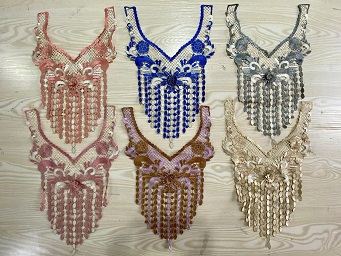A Brief History of Lace Collars
2025-02-05
Lace collars have long been a symbol of elegance, sophistication, and social status. From their early beginnings in the Renaissance period to their influence on modern fashion, lace collars have endured the test of time, evolving with changing styles and cultural trends. This blog explores the fascinating history of lace collars and their impact on fashion through the centuries.
The Origins of Lace Collars
Lace-making began in Europe during the late 15th and early 16th centuries, primarily in Italy and Flanders (modern-day Belgium). As lace became more intricate and desirable, it quickly found its way into high fashion, particularly among the European aristocracy. The first lace collars appeared in the 16th century, often worn by both men and women as a symbol of wealth and refinement.
The Renaissance and Baroque Eras (16th–17th Century)
During the Renaissance, lace collars became a distinctive feature of European fashion. The ruff, a stiff and elaborate lace collar, was popularized by figures such as Queen Elizabeth I of England and King Philip II of Spain. These collars were often large, intricately designed, and required special starching techniques to maintain their shape.
As fashion evolved into the Baroque period, ruffs gave way to more relaxed lace collars, such as the falling band, which draped gracefully over the shoulders. These collars were often adorned with fine embroidery and delicate lace patterns, adding a touch of sophistication to noble attire.

The 18th and 19th Century: Refinement and Elegance
By the 18th century, lace collars became less rigid and more integrated into women's clothing. Delicate lace trims and jabots (frilled lace neckpieces) were popular among aristocratic women. The French court, under figures like Marie Antoinette, embraced lace as a staple of feminine elegance.
In the 19th century, lace collars became more accessible due to advances in textile production. With the rise of the Victorian era, high lace collars became a signature feature of women's fashion, symbolizing modesty and refinement. The advent of machine-made lace made these accessories more widely available, allowing the middle class to adopt the trend.
The 20th Century to Present: Revival and Reinvention
During the 20th century, lace collars saw periodic revivals. The Edwardian era (early 1900s) featured high lace collars in women's dresses, emphasizing grace and femininity. In the 1960s, lace collars gained renewed popularity, often seen in vintage-inspired designs and influenced by historical fashion.
Today, lace collars continue to be a stylish and elegant accessory. They are often incorporated into contemporary fashion, from high-fashion runways to casual wear. Designers continue to experiment with lace patterns, blending traditional craftsmanship with modern aesthetics.
Conclusion
Lace collars have remained a timeless fashion statement, evolving through centuries while retaining their charm and elegance. From the elaborate ruffs of the Renaissance to the delicate accents of modern designs, lace collars have left a lasting impact on fashion history. Whether worn for elegance, tradition, or personal style, lace collars continue to be a symbol of sophistication and refinement.


